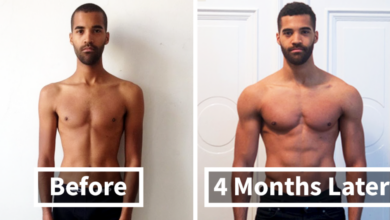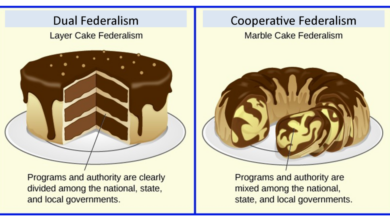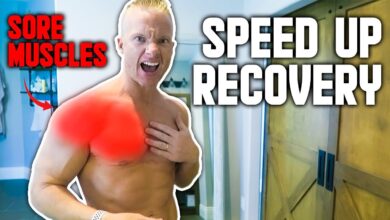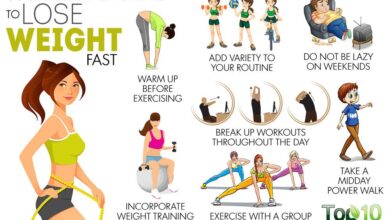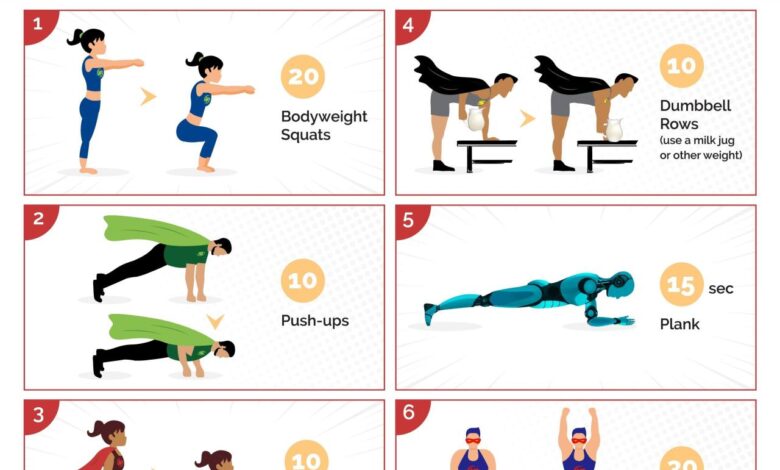
Quick Home Bodyweight Workout: Get Fit Anywhere
Quick home bodyweight workouts offer a convenient and effective way to get fit without needing any equipment. They’re perfect for busy individuals who want to squeeze in a workout without leaving the comfort of their homes. Imagine a quick, energizing routine that targets all your major muscle groups, leaving you feeling strong and energized.
This guide delves into the world of bodyweight exercises, providing a sample workout routine, variations for different fitness levels, and tips for proper form and progression. We’ll also explore the importance of nutrition, recovery, and safety considerations to maximize your results and minimize the risk of injury.
Bodyweight Workouts at Home: Your Path to Fitness
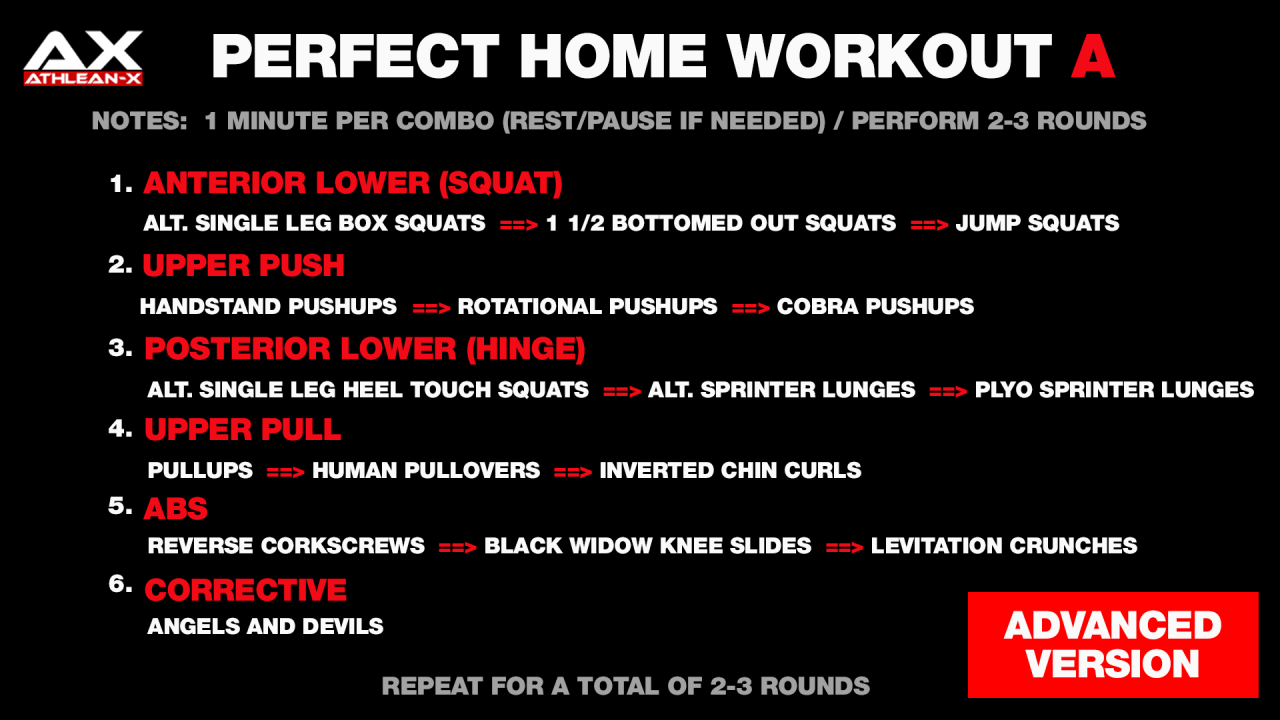
Bodyweight workouts offer a fantastic way to achieve fitness goals from the comfort of your own home. They eliminate the need for expensive gym memberships and specialized equipment, making fitness accessible to everyone. The simplicity and effectiveness of bodyweight exercises make them a convenient and powerful tool for building strength, endurance, and overall well-being.
Convenience and Accessibility
Bodyweight exercises require no special equipment or memberships, making them incredibly convenient and accessible. You can perform them anytime, anywhere, without having to travel to a gym or wait for equipment. This flexibility allows you to easily incorporate fitness into your daily routine, even with a busy schedule.
For instance, you can squeeze in a quick workout during your lunch break, before bed, or even while watching television.
Examples of Bodyweight Exercises
Bodyweight exercises encompass a wide range of movements that target various muscle groups. Here are some examples of exercises you can perform at home:
- Push-ups:A classic exercise that works your chest, shoulders, and triceps.
- Squats:A compound exercise that strengthens your legs, glutes, and core.
- Lunges:A great exercise for targeting your quads, hamstrings, and glutes.
- Plank:A static exercise that strengthens your core, back, and shoulders.
- Burpees:A full-body exercise that combines a squat, push-up, and jump, improving your cardiovascular fitness and strength.
Workout Structure: Quick Home Bodyweight Workout
A structured workout routine is essential for achieving your fitness goals. It provides a framework for consistency, progress, and injury prevention. A typical workout structure involves a warm-up, a main workout session, and a cool-down.
Sample Quick Home Bodyweight Workout Routine
This sample routine combines a mix of exercises targeting different muscle groups for a well-rounded workout.
Warm-Up (5 minutes)
A proper warm-up prepares your body for exercise, increasing blood flow, flexibility, and core temperature.
- Jumping jacks (30 seconds)
- High knees (30 seconds)
- Butt kicks (30 seconds)
- Arm circles (forward and backward, 30 seconds each)
- Dynamic stretches, such as arm swings and leg swings (1 minute)
Workout (15 minutes)
The workout section focuses on building strength and endurance.
| Exercise | Sets | Reps | Rest Time |
|---|---|---|---|
| Squats | 3 | 10-12 | 60 seconds |
| Push-ups | 3 | As many as possible (AMRAP) | 60 seconds |
| Lunges (alternate legs) | 3 | 10-12 per leg | 60 seconds |
| Plank | 3 | 30-60 seconds | 60 seconds |
| Crunches | 3 | 15-20 | 60 seconds |
Cool-Down (5 minutes)
A cool-down helps your body gradually return to a resting state.
Sometimes, a quick home bodyweight workout is all you need to feel energized. No fancy equipment, just your own body and a little motivation! But while you’re working out, you might be thinking about what to eat afterward.
Is it okay to enjoy some pasta? Turns out, it can be! Check out this article on can pasta be healthy to learn more. After all, a balanced diet is just as important as a good workout routine.
- Static stretches, such as holding a hamstring stretch or a quad stretch (5 minutes)
Benefits of Exercises
Each exercise in this routine offers specific benefits:
- Squats: Engage multiple muscle groups, including quads, glutes, hamstrings, and calves, improving lower body strength and power.
- Push-ups: Build upper body strength, particularly in the chest, shoulders, and triceps.
- Lunges: Target quads, hamstrings, and glutes, improving balance, stability, and lower body strength.
- Plank: Strengthen core muscles, including the abs, obliques, and lower back, improving posture and stability.
- Crunches: Strengthen abdominal muscles, improving core strength and definition.
Exercise Variations
Bodyweight exercises are incredibly versatile and can be modified to suit various fitness levels. By adjusting the exercise form and adding variations, you can challenge yourself and continue to progress. This section explores different variations of common bodyweight exercises, providing a deeper understanding of how to personalize your workouts.
Variations of Common Bodyweight Exercises
Bodyweight exercises can be modified to target different muscle groups, increase difficulty, and enhance overall fitness. Below is a table outlining variations of common bodyweight exercises, their difficulty level, target muscle groups, and additional tips.
A quick home bodyweight workout is a great way to get your blood flowing and your muscles working, even on a busy day. And after you’ve finished your workout, you might be craving a warm and comforting meal. Why not try a hearty winter soup?
9 hearty winter soups under 360 calories can be the perfect post-workout fuel, providing you with essential nutrients and helping you recover. Plus, they’re a great way to stay warm on a chilly day. So, get your workout in, and then settle down with a bowl of delicious, healthy soup!
| Exercise Variation | Difficulty Level | Target Muscle Groups | Additional Tips |
|---|---|---|---|
| Standard Push-up | Beginner | Chest, Triceps, Shoulders | Keep your body in a straight line from head to heels, engaging your core. |
| Inclined Push-up | Intermediate | Chest, Triceps, Shoulders | Perform push-ups with your hands elevated on a bench or surface. This variation reduces the difficulty by decreasing the angle of your body. |
| Decline Push-up | Advanced | Chest, Triceps, Shoulders | Perform push-ups with your feet elevated on a bench or surface. This variation increases the difficulty by increasing the angle of your body. |
| Diamond Push-up | Intermediate | Chest, Triceps | Place your hands close together, forming a diamond shape with your thumbs and index fingers. This variation emphasizes the triceps. |
| Clap Push-up | Advanced | Chest, Triceps, Shoulders | Perform a push-up, explosively pushing yourself off the ground and clapping your hands together before returning to the starting position. This variation requires strength and power. |
| Standard Squat | Beginner | Quadriceps, Glutes, Hamstrings | Keep your back straight, core engaged, and descend until your thighs are parallel to the ground. |
| Goblet Squat | Intermediate | Quadriceps, Glutes, Hamstrings, Core | Hold a weight (such as a dumbbell) in front of your chest. This variation increases core engagement and stability. |
| Pistol Squat | Advanced | Quadriceps, Glutes, Hamstrings, Core | Perform a squat with one leg extended in front of you. This variation requires balance and strength. |
| Jump Squat | Intermediate | Quadriceps, Glutes, Hamstrings, Calves | Explosively jump up from a squat position. This variation increases power and explosiveness. |
| Standard Lunge | Beginner | Quadriceps, Glutes, Hamstrings | Step forward with one leg, bending both knees to 90 degrees. Keep your front knee aligned with your toes. |
| Walking Lunge | Intermediate | Quadriceps, Glutes, Hamstrings | Perform lunges in a walking motion, alternating legs with each step. This variation increases cardiovascular activity. |
| Reverse Lunge | Intermediate | Quadriceps, Glutes, Hamstrings | Step backward with one leg, bending both knees to 90 degrees. Keep your front knee aligned with your toes. |
| Lateral Lunge | Intermediate | Inner Thighs, Glutes | Step sideways with one leg, bending your knee and keeping your other leg straight. This variation targets the inner thighs and glutes. |
“Modifying exercises for different fitness levels involves adjusting the range of motion, adding resistance, or changing the exercise’s intensity. For beginners, focus on proper form and gradual progression. As you get stronger, increase the difficulty by adding variations or using resistance bands.”
Proper Form and Technique
Proper form is essential for effective and safe bodyweight workouts. It ensures that you target the correct muscles, prevent injuries, and maximize your results. This section will guide you through the correct form for each exercise in the routine, provide tips on maintaining proper form, and explain how to adjust technique for different body types and fitness levels.
Maintaining Proper Form
Maintaining proper form is crucial for reaping the benefits of bodyweight exercises and avoiding injuries.
- Engage Your Core:Throughout every exercise, engage your core muscles by tightening your abdominal muscles and keeping your back straight. This provides stability and protects your spine.
- Control the Movement:Avoid rushing through the exercises. Move slowly and with control, focusing on each muscle group involved. This allows you to feel the exercise and prevents strain.
- Listen to Your Body:Pay attention to your body’s signals. If you feel any pain, stop the exercise and rest. Adjust the form or intensity as needed.
Common Form Mistakes and Solutions
Several common mistakes can hinder the effectiveness and safety of bodyweight exercises. Here are some common mistakes and solutions:
- Rounded Back During Push-Ups:This puts unnecessary strain on your lower back. Solution:Engage your core and keep your back straight, forming a straight line from your head to your heels.
- Swinging Legs During Squats:This reduces the effectiveness of the exercise and increases the risk of injury. Solution:Keep your legs still and focus on using your leg muscles to lower and raise your body.
- Arching Back During Planks:This puts strain on your lower back and reduces the effectiveness of the exercise. Solution:Keep your body in a straight line from your head to your heels, engaging your core and glutes.
Adjusting Exercise Technique for Different Body Types and Fitness Levels, Quick home bodyweight workout
Bodyweight exercises can be adapted to suit various body types and fitness levels.
- Modifying Exercises for Beginners:Beginners can modify exercises by using easier variations. For example, they can perform knee push-ups instead of full push-ups or wall sits instead of squats.
- Increasing Difficulty for Advanced Users:Advanced users can increase the difficulty by adding more repetitions, sets, or by incorporating variations that challenge their strength and stability. For instance, they can try one-legged squats or handstand push-ups.
Progression and Challenges
As you become more comfortable with the exercises and your body adapts, you can increase the challenge and intensity of your workouts. This will lead to greater strength, endurance, and muscle growth.
Progression Plan for Bodyweight Exercises
A progression plan helps you gradually increase the difficulty of exercises, ensuring you challenge your body without risking injury. This is achieved by introducing variations that increase the demand on your muscles.
Sometimes, the best workouts are the ones you can do right at home, without any equipment. A quick bodyweight circuit can be a great way to get your heart rate up and build strength. Afterward, reward yourself with some delicious pumpkin-flavored snacks – I recommend checking out 8 RD-approved pumpkin flavored snacks to buy at Trader Joe’s for some healthy and satisfying options.
Then, get back to that workout – you’ve got this!
- Increase repetitions:Start with a number of repetitions you can comfortably complete with good form. Gradually increase the number of repetitions as you get stronger.
- Increase sets:Once you can perform a desired number of repetitions, increase the number of sets you perform.
- Decrease rest time:Reducing rest time between sets will increase the intensity of your workout.
- Add resistance:For advanced bodyweight exercises, you can add resistance bands or weighted vests to increase the challenge.
Advanced Bodyweight Exercises
For those seeking a greater challenge, advanced bodyweight exercises can help take your fitness to the next level.
- Handstand push-ups:A challenging exercise that strengthens your shoulders, triceps, and core.
- Muscle-ups:A combination of a pull-up and a dip, this exercise targets your back, chest, shoulders, and biceps.
- Pistol squats:A single-leg squat that requires significant balance and leg strength.
- Planche push-ups:An advanced push-up variation that requires significant strength and core stability.
Tracking Progress and Adjustments
Tracking your progress is essential to see how your fitness is improving and to make adjustments to your workout routine as needed.
- Keep a workout log:Record the exercises you perform, the number of repetitions and sets, and your rest times.
- Measure your progress:Take measurements of your body composition, such as weight, body fat percentage, and muscle mass.
- Assess your performance:Pay attention to how you feel during your workouts. If you find yourself struggling to complete the exercises with good form, it may be time to adjust your routine.
Nutrition and Recovery
Your bodyweight workout routine is only as effective as your ability to fuel and recover properly. Nutrition and recovery are crucial for maximizing your results and preventing injury.
Fueling Your Workouts
A balanced diet is essential for providing your body with the energy and nutrients it needs to perform at its best. You need to consume adequate carbohydrates for energy, protein for muscle repair and growth, and healthy fats for hormone production and cell function.
- Carbohydrates:Carbohydrates are your body’s primary energy source. Choose complex carbohydrates like whole grains, fruits, and vegetables, which provide sustained energy release.
- Protein:Protein is essential for building and repairing muscle tissue. Aim to consume a good source of protein with each meal, such as lean meats, poultry, fish, eggs, dairy products, beans, and lentils.
- Healthy Fats:Healthy fats, such as those found in avocados, nuts, seeds, and olive oil, are important for hormone production, cell function, and overall health.
Optimizing Recovery
Recovery is just as important as the workout itself. It allows your body to repair and rebuild muscle tissue, making you stronger and more resilient for your next workout.
- Rest:Give your body adequate rest between workouts. Aim for at least one day of rest per week, or more if you’re feeling particularly sore or fatigued.
- Active Recovery:Light activities like walking, swimming, or yoga can help improve blood flow and reduce muscle soreness.
- Stretching:Stretching helps improve flexibility and range of motion, which can reduce muscle soreness and prevent injuries.
- Foam Rolling:Foam rolling can help release muscle tension and improve flexibility.
- Hydration:Staying hydrated is essential for recovery. Water helps transport nutrients to muscles and flush out waste products.
The Role of Sleep and Hydration
Sleep and hydration play a crucial role in your overall fitness journey.
Sleep
- Sleep is essential for muscle repair and growth. During sleep, your body releases hormones that promote muscle growth and repair.
- Sleep deprivation can lead to decreased performance, increased muscle soreness, and a higher risk of injury.
- Aim for 7-9 hours of quality sleep per night.
Hydration
- Water is essential for many bodily functions, including regulating body temperature, transporting nutrients, and flushing out waste products.
- Dehydration can lead to fatigue, muscle cramps, and decreased performance.
- Drink plenty of water throughout the day, especially before, during, and after your workouts.
Final Summary
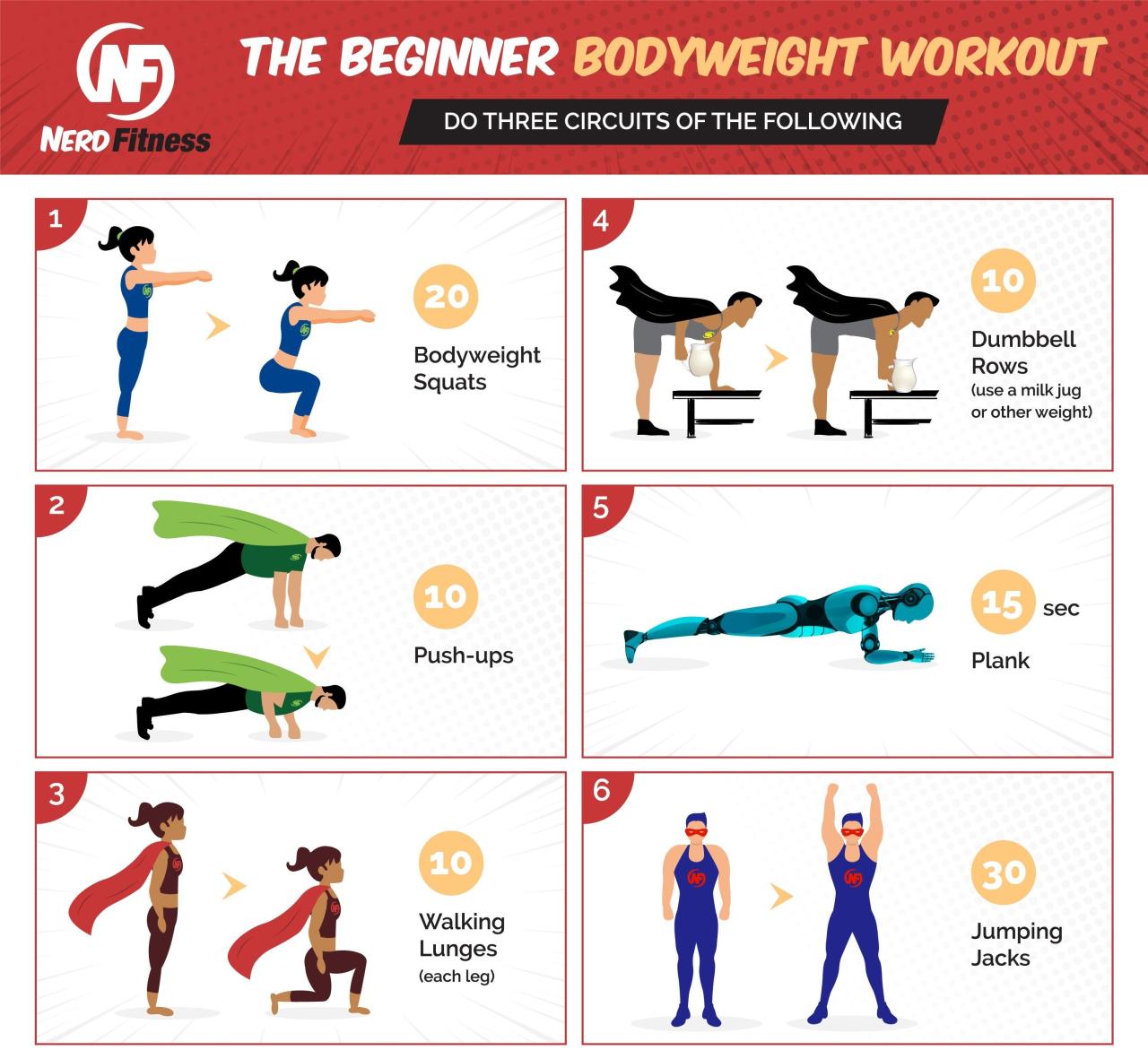
By incorporating quick home bodyweight workouts into your routine, you’ll experience the joy of fitness without needing a gym membership. Remember to listen to your body, focus on proper form, and gradually increase the intensity as you get stronger. You’ll be surprised at how much you can achieve with just your own bodyweight!

